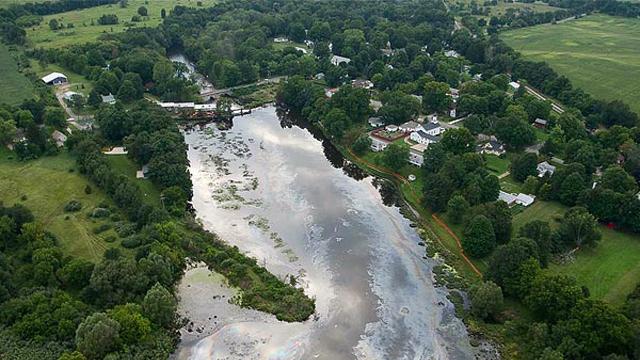
Photo: courtesy Michigan Department of Environmental Quality. More than a million gallons of dilbit leaked into Michigan's Kalamazoo River in July 2010.
Just when it seemed that the Keystone XL pipeline was on hold, TransCanada Corp. segmented the project and the U.S. government fast-tracked the environmental review process. This allows TransCanada to begin construction on the southern part of the Keystone XL this summer.
With a nonviolent direct action camp that started July 27, 2012 in East Texas, grassroots opponents are working on a construction project of their own: Tar Sands Blockade, a coalition of landowners, community members, students, and others dedicated to stopping the pipeline through direct action.
Building in Segments to Get around Opposition
The Keystone XL pipeline was originally proposed as a single line that went from Alberta to Texas. However, in February, TransCanada announced that the southern part of the Keystone XL had been reconceived as a separate pipeline called the Gulf Coast Project.
TransCanada spokesperson David Dodson characterizes the Gulf Coast pipeline as important for the energy security of the United States. According to Dodson, domestic producers “do not have access to enough pipeline capacity to move the production to the large refining market along the U.S. Gulf Coast.”
In March, U.S. President Barack Obama expedited the review process for pipelines going from Oklahoma to Texas. “In part due to rising domestic production, more oil is flowing in than can flow out, creating a bottleneck that is dampening incentives for new production while restricting oil from reaching state-of-the-art refineries on the Gulf Coast,” reads the president's March 22 memo. In a whopping 86-word sentence, the president goes on to explain that all agencies are to “coordinate and expedite their reviews, consultations, and other processes as necessary to expedite decisions related to domestic pipeline infrastructure projects.”
Following the President's order to expedite the review process, the Sierra Club, Oklahoma and Texas landowners, and the Texas communities of Reklaw, Gallatin, and Alto filed a lawsuit against the U.S. Army Corps of Engineers (USACE), which issues water permits.
Tar Sands Blockade spokesperson Ron Seifert explained that the president was under no obligation to come forward and expedite the Gulf Coast Project review process. “The president expedited the project not because he had to, but because he wanted to show support for our oil and gas industry,” Seifert said. “It wasn't mandated by any laws. But in doing so, our Environmental Protection Agency was persuaded to stand down and the result is that the more thorough water crossing investigations and hearings along the pipeline route are basically bypassed.”
USACE names environmental sustainability as a guiding principle.
A Lesson from Enbridge
Another organization that highlights its interest in sustainability is Enbridge, Inc. The company joined forces with the University of Calgary’s Haskayne School of Business on March 27, 2012, to unveil the Enbridge Centre for Corporate Sustainability.
But these days the name Enbridge is more likely to evoke images of its 2010 oil spill, in which 20,000 barrels of oil flowed into Michigan’s Kalamazoo River. The disaster has been called the largest inland oil spill in the history of the U.S. Midwest.
In its July 25 report on the Enbridge oil spill, the U.S. National Transportation Safety Board twice recommends that Enbridge require its operators “to provide system-specific information about their pipeline systems to the emergency response agencies of the communities and jurisdictions in which those pipelines are located.” The report goes on to say that these reports should include details such as “pipe diameter, operating pressure, product transported, and the potential impact radius.”
Seifert from Tar Sands Blockade indicated that TransCanada has not disclosed the pipeline contents to landowners. In a phone interview from Texas, he expressed concern about chemicals used to dilute bitumen. Bitumen requires dilution because it is too thick to flow through pipelines by itself. And there is fear that diluted bitumen, or “dilbit,” will pass through the Gulf Coast Project if the northern part of the Keystone XL is built. Diluted bitumen contains carcinogenic benzenes and toxic heavy metals.
Referring to the National Transportation Safety Board report, Seifert says that Enbridge “increased their pipeline pressure on several occasions leading up to the accident. They did that because they were getting false readings from gas bubbles in their pipe. So that's an endemic flaw of tar sands dilbit because they mix and dilute tar sands with this natural gas condensate, which creates gas pockets and creates false pressure readings.”
Council of Canadians Energy and Climate Justice Campaigner Maryam Adrangi concurs with Seifert's observation about the oil and gas industry's lack of transparency. “They talk a lot about hypothetical [pipeline] routes lately. You think in the back of your mind, these companies have to have an idea of where they want to put these projects,” Adrangi said in a phone interview from Vancouver. “There's just a general lack of transparency when it comes down to it.”
Christine Leclerc is a Vancouver-based author and activist. She is an editor of the recently published collection The Enpipe Line: 70,000+ kilometres of poetry written in resistance to the Enbridge Northern Gateway Pipelines proposal. You can follow her on Twitter @xineleclerc.
3 WAYS TO SHOW YOUR SUPPORT
- Log in to post comments











